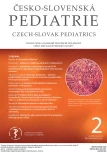The importance of long-term follow-up of patients with nephropathy
Authors:
O. Dobrovanov 1,2,3; K. Furková 1,2; K. Birková 1
Authors‘ workplace:
Klinika pre deti a dorast A. Getlíka LF SZU a UNB, Nemocnica sv. Cyrila a Metoda, Bratislava, Slovenská republika
1; Slovenská zdravotnícka univerzita, Bratislava, Slovenská republika
2; Vysoká škola zdravotníctva a sociálnej práce sv. Alžbety, n. o., Bratislava, Slovenská republika
3
Published in:
Čes-slov Pediat 2021; 76 (2): 85-90.
Category:
Overview
Kidney diseases are a common problem in adolescence, their spectrum has some specifics. Urinary tract infections clearly predominate in adolescent girls, but in general, the most common reason for adolescents to visit a nephrology clinic is isolated erythrocyturia or proteinuria. The aim of our efforts is to point out the fact that even seemingly insignificant diagnoses (isolated erythrocyturia) progress to severe chronic kidney disease. A large percentage of these diagnoses are previously undiagnosed tubulointerstitial nephritis, so long-term follow-up is important. Only a well-established diagnosis will allow the right treatment to be used to prevent the development of chronic kidney disease or chronic renal failure.
Keywords:
adolescence – erythrocyturia – long-term follow-up – nephropathy – Proteinuria
Sources
1. Encyklopedický ústav SAV. Encyclopaedia Beliana. 1. vyd. Bratislava: Veda 1999 : 1–696. https://beliana.sav.sk/heslo/adolescencia.
2. Furková K, Šašinka M. Adolescentná nefrológia. Via pract 2007; 4 (3): 120–123.
3. Janda J, Stolcova P, Sikut M, et al. The solitary kidney in children and adolescents. Morphologic and functional characteristics. Čes-slov Pediat 1991; 46 : 195–199.
4. Teplan V, Horáčková M, Bébrová E, et al. Infekce ledvin a močových cest v dospělém a dětském věku. Praha: Grada. 2004 : 1–252.
5. Janda J, Seeman T, Dušek J, et al. Autozomálně recesivní a autozomálně dominantní polycystická choroba ledvin u dětí. Čes-slov Pediat 1999; 54 : 399–405.
6. Vachek J, Zakiyanov O, Tesař V. Chronické onemocnění ledvin – aktuální situace. Medicína po promoci 2014; 15 (4). http://www.tribune.cz/clanek/34685chronicke-onemocneni-ledvin-aktualni-situace.
7. Šašinka M, Furková K. Chronická obličková choroba. Bratislava: Herba 2014 : 1–360.
8. Spustová V, Demeš M. Svetový deň obličiek. Lek Obzor 2009; 6. http://www.lekarsky.herba.sk/lekarsky-obzor-6-2009/svetovy-den-obliciek.
9. Koľvek G, Kizeková Z, Dluholucký M, et al. Terminálne zlyhanie obličiek u detí na Slovensku Epidemiológia z Európskej perspektívy. Čes-slov Pediat 2012; 67 (Suppl 1): 18–24.
10. Krásničanová P, Pozler O. Compliance u chronických chorob v období adolescence. Čes-slov Pediat 2008; 63 (9): 495–500.
11. Spustová V. Definícia, hodnotenie a klasifikácia ochorenia obličiek. Via pract 2010; 7 (4): 152–154.
12. Illéšová E, Demeš M, Dostálová K, a kol. Chronická obličková choroba – významný celosvetový zdravotný problém. Verejné zdravotníctvo [online] 2010; VII(4): 1–8.
13. Šašinka M, Furková K. Nefrológia v súčasnosti. Lek Obzor 2009; 6. http://www.lekarsky.herba.sk/lekarsky-obzor-6-2009/nefrologia-v-sucasnosti.
14. Šašinka M, Podracká Ľ. Pediatrická prevencia pri chronických chorobách obličiek. Čes-slov Pediat 2008; 63 (10): 580–586.
15. Watson AR, Harden P, Ferris M, et al. Transition from pediatric to adult renal services: a consensus statement by the international society of nephrology (ISN) and the international pediatric nephrology association (IPMA). Kidney Int 2011; 80 : 704–707.
16. Colver A, et al. Facilitating transition of young people with long-term health conditions from children‘s to adults‘ healthcare services – implications of a 5-year research programme. Clin Med (London, England) 2020; 2 (1): 74–80.
17. Černianská A, Červeňová O, Zatlukalová S. Nefrologický pacient v ambulancii VLDD. 2. dni primárnej pediatrie. 12.–13. Máj 2017 (Grand hotel Jasná). Zborník príspevkov. 2017 : 16–17.
18. Seeman T, Janda J. Dětská nefrologie. Praha: Mladá fronta, 2015 : 1–525.
19. Kráľová E, Granatierová I. Súčasné možnosti farmakoterapie a prevencie infekcií dolných močových ciest. Via pract 2014; 11 (6): 226–228.
20. Dobrovanov O, Králinský K, Babeľa R, a kol. Dôležitosť skríningu obštrukčných uropatií u novorodencov. Pediatria (Bratisl.) 2018; 13 (1): 17–20.
21. Dobrovanov O, Králinský K. Porovnanie efektivity a senzitivity prenatálnej a postnatálnej sonografickej diagnostiky vrodených vývojových chýb obličiek na Slovensku. Lek Obzor 2020; 69 (4): 130–133.
22. Podracká Ľ, Kovács L. Hematúria v pediatrickej praxi. Pediatr Prax 2011; 12 (4): 143–145.
23. Hattori M, Iwano M, Sako M, et al. Transition of adolescent and young adult patients with childhood-onset chronic kidney disease from pediatric to adult renal services: a nationwide survey in Japan. Clin Exp Nephrol 2020; 20 : 918–925 (2016).
Labels
Neonatology Paediatrics General practitioner for children and adolescentsArticle was published in
Czech-Slovak Pediatrics

2021 Issue 2
- What Effect Can Be Expected from Limosilactobacillus reuteri in Mucositis and Peri-Implantitis?
- The Importance of Limosilactobacillus reuteri in Administration to Diabetics with Gingivitis
Most read in this issue
- Dysthymia as a less known form of depression: clinical picture and treatment
- Substance and non-substance addictions in adolescence
- Hantavirus hemorrhagic fever with renal syndrome – first pediatric cases in Slovakia
- Dorostové lékařství
